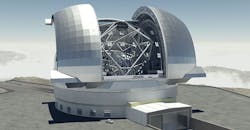2,300+ Actuators to Position Almost 200 Tons of Mirrors for Telescope
Engineers working on the prosaically named Extremely Large Telescope (ELT) in the Chilean Atacama Desert were faced with several daunting challenges. One of them was to devise a positioning subsystem for the 798 hexagonal mirrors that work together as the telescope’s 39-meter primary mirror, which will cover a surface area of almost 1,000 m2. That will let it collect 100 million times more light than a human eye—or, perhaps a more fair comparison is that it will have 250 times the light gathering area as the Hubble Space Telescope.
The positioning subsystem will consist of three independently controlled position actuators (PACTs) for each mirror, and each trio of PACTs has to hold its mirror in place to within 2 nm RMS. The PACTs also have to exert up to 900 N of force (or 203 pound-force) and move their mirrors up to 15 mm on three axes that have been dubbed piston, tilt, and tilt. With a millimeter equal to 106 nanometers, the PACTs could not have their speed limited to 10 or 20 nanometers per second. They needed to combine two ranges of speed and motion.
The controller for the primary mirror will initiate adjustments to the PACTs so that the primary mirror retains its shape despite deformations caused by changes in telescope elevation, temperature, and wind forces. It will also compensate for vibrations from machinery and a large cooling system needed to minimize the thermal effects on the optics and incoming light.
The design team was unable to find a stock actuator that could handle all of the necessary requirements. Consequently, it turned to Physik Instrumente (PI), a German firm with more than 40 years of experience in designing and building precision motion-control devices.
PI engineers eventually settled on a hybrid design that combines a brushless DC motor with backlash-free, 100:1 harmonic drive gearhead and a 0.5 mm-pitch stiff roller screw for the longer motions and piezo stack actuators for the smaller, more precise motions. They are controlled simultaneously by a single controller taking in positional feedback readings from an optical sensor providing subnanometer (0.125 nm) resolution.
The telescope, a project of the European Southern Observatory (ESO), will cost about $1.2 billion and be the world’s largest optical reflecting telescope when it becomes operational in 2024. ESO, formerly known as the European Organization for Astronomical Research in the Southern Hemisphere, is a 16-nation research organization dedicated to ground-based astronomy that was formed in 1962.




